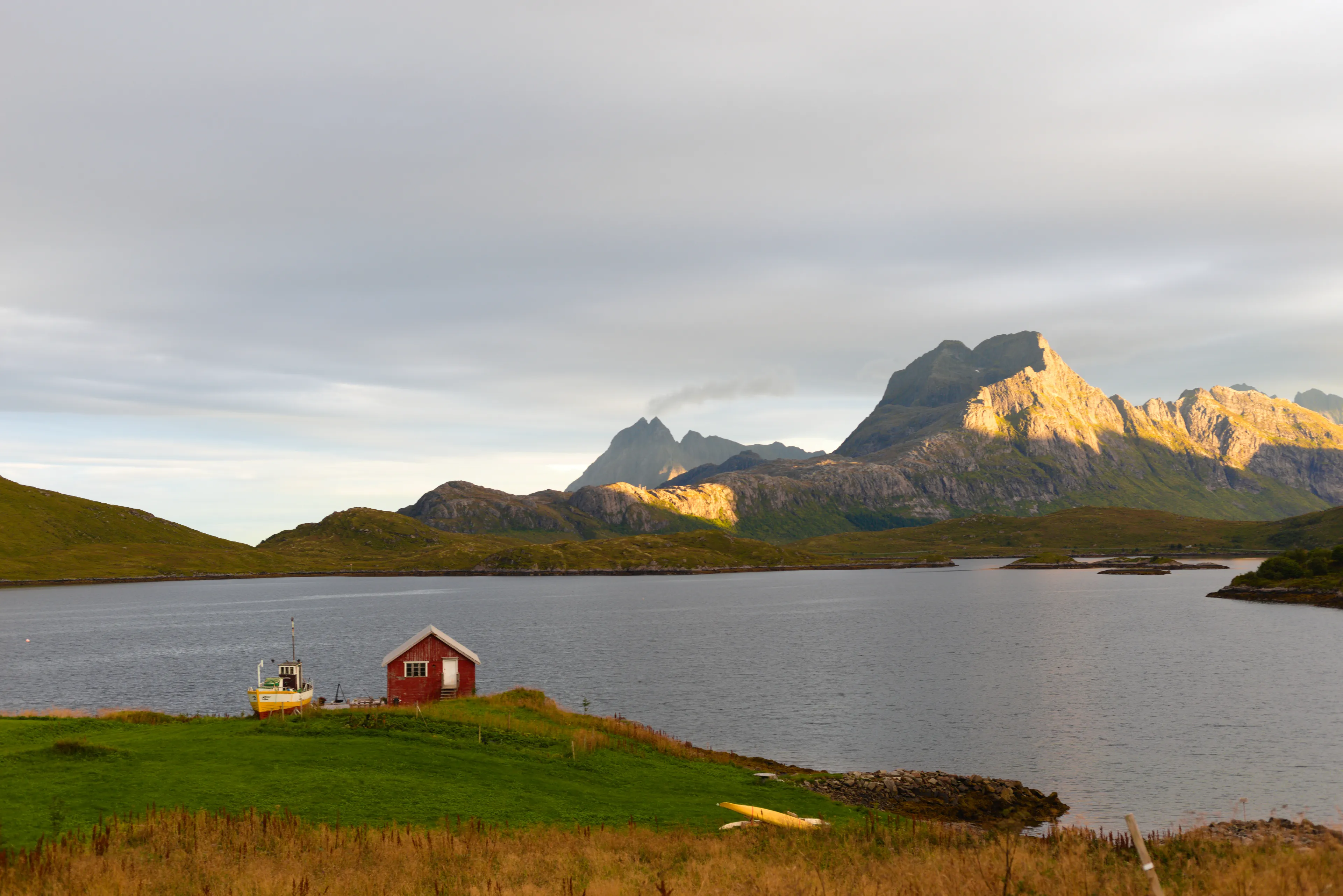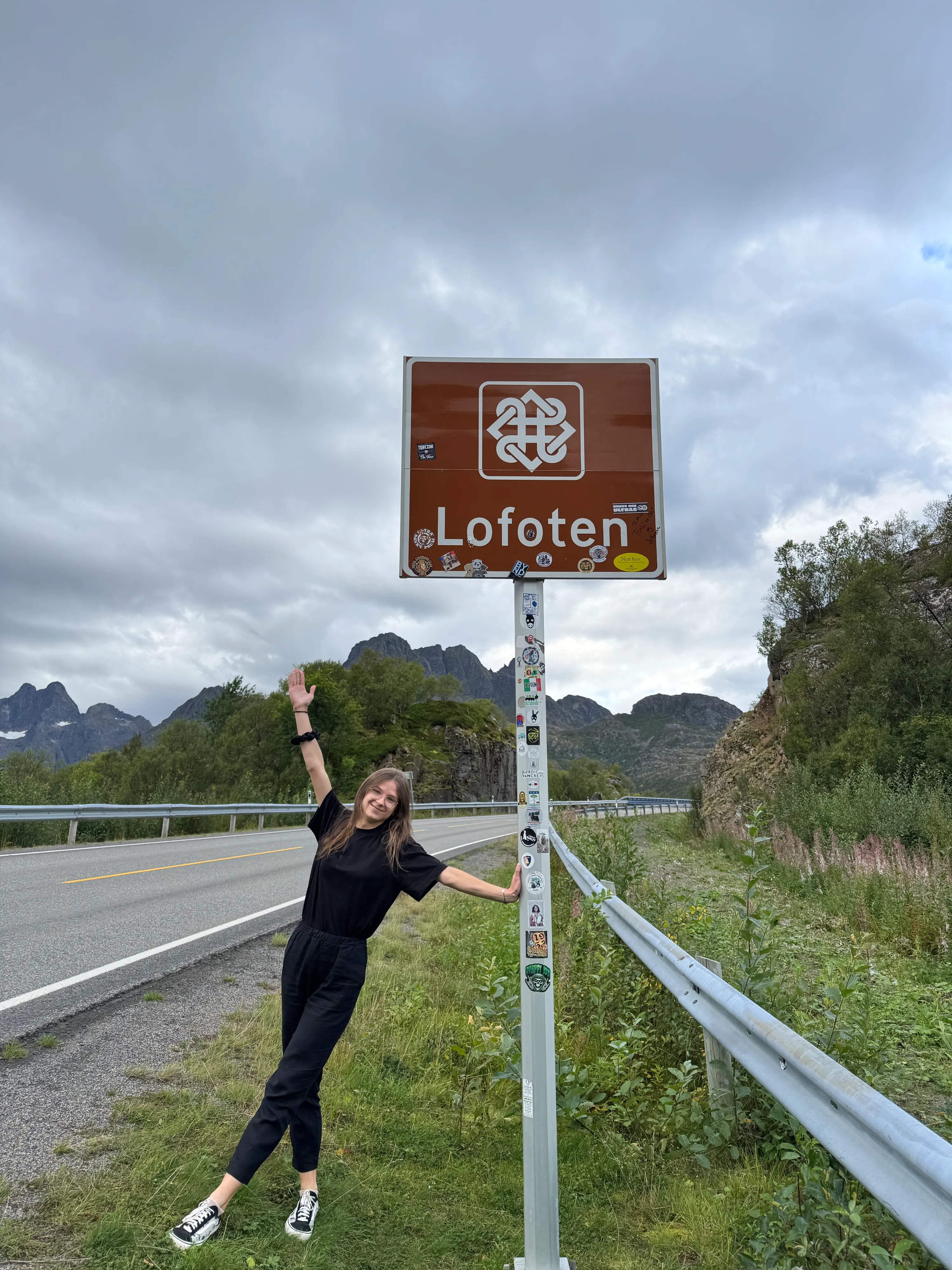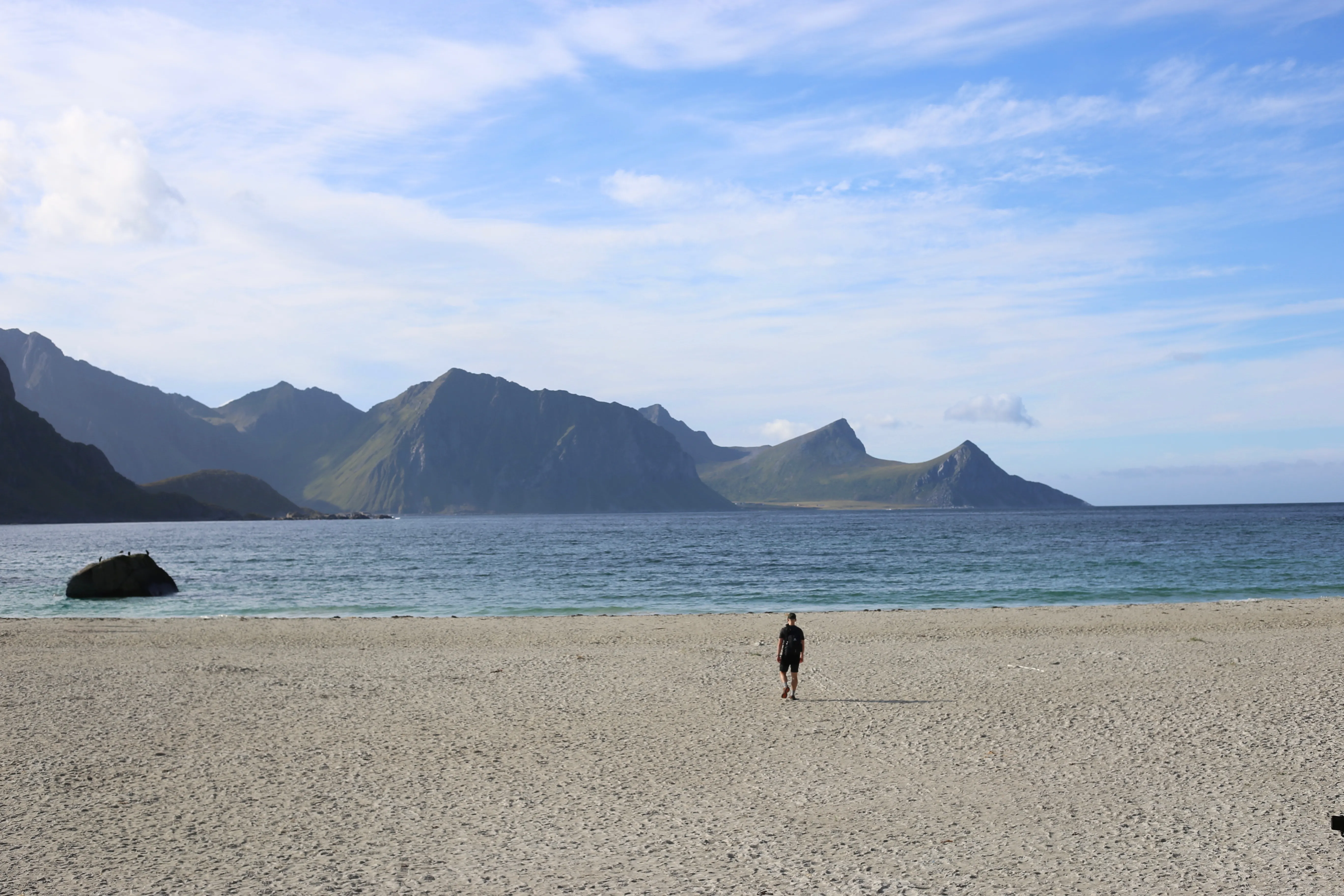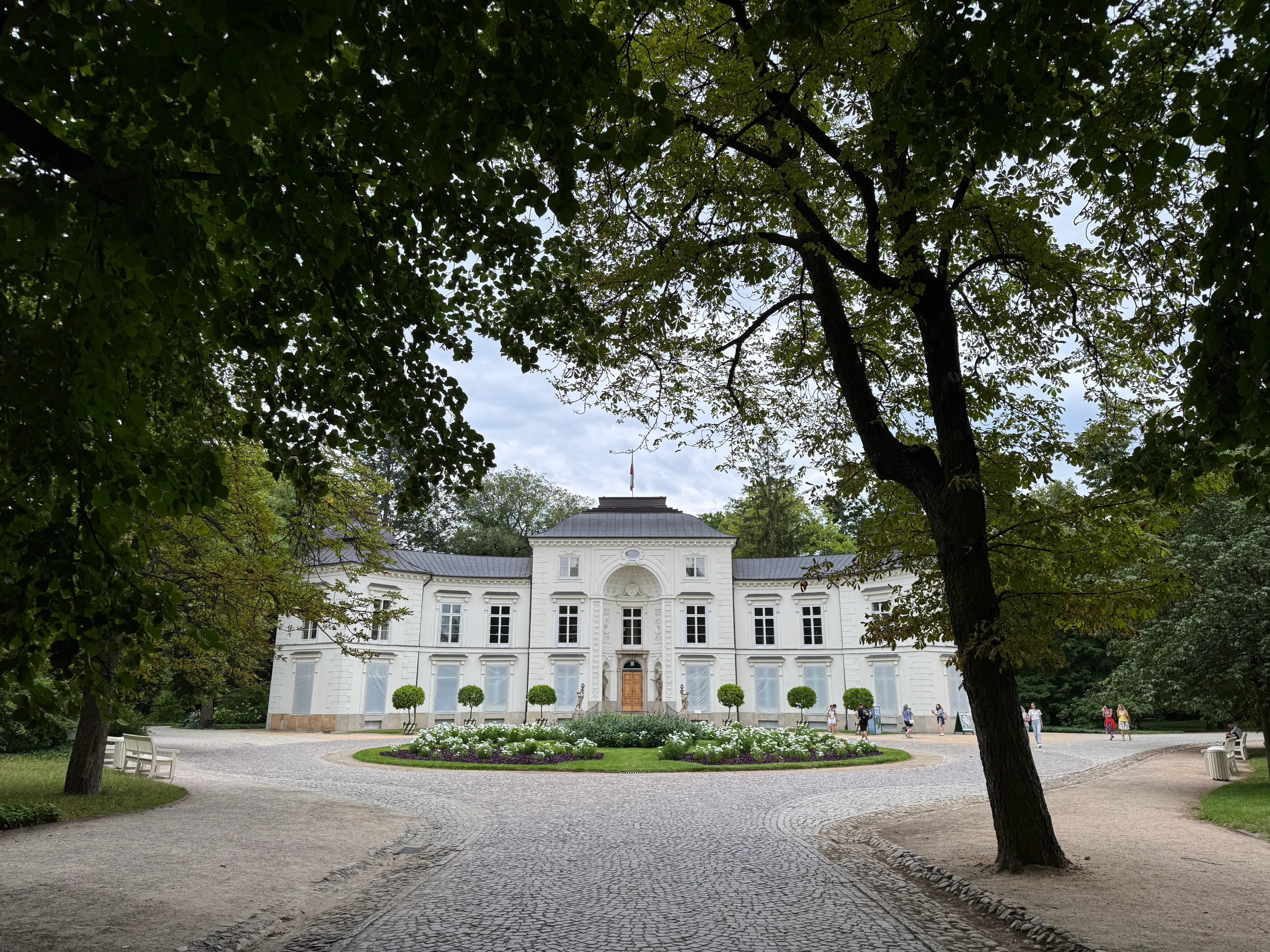Lofoten - Introduction
The Lofoten Islands are one of the most picturesque archipelagos in northern Norway, stretching about 112 km in length. They consist of islands connected by bridges and underwater tunnels, the largest of which are Austvågøy, Vestvågøy, Moskenesøya, Flakstadøya, and Gimsøya. The capital of the region is Svolvær, the largest town and starting point for many travelers, and therefore the most touristy place. The characteristic landscape of Lofoten is formed by steep, rocky massifs rising straight from the sea, sharply ending peaks and jagged mountain ridges, between which short but extremely picturesque fjords squeeze in. It is precisely this contrast of rugged, towering mountains and calm bays, plus the atmospheric cottages in traditional Norwegian style, that makes the archipelago considered one of the most beautiful places in all of Norway. It's no wonder that this destination is enjoying increasing interest among travelers from around the world.
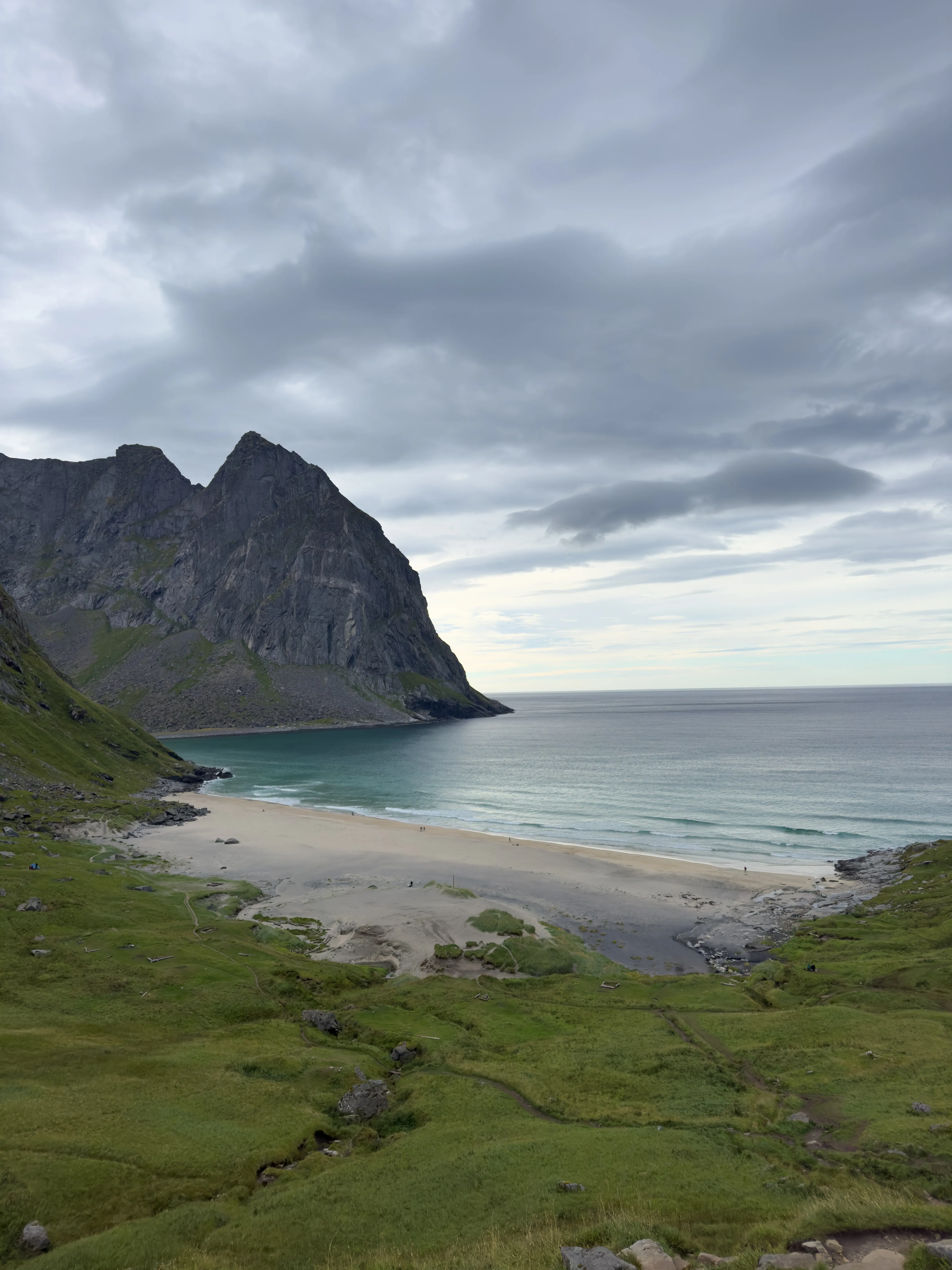
Kvalvika Beach
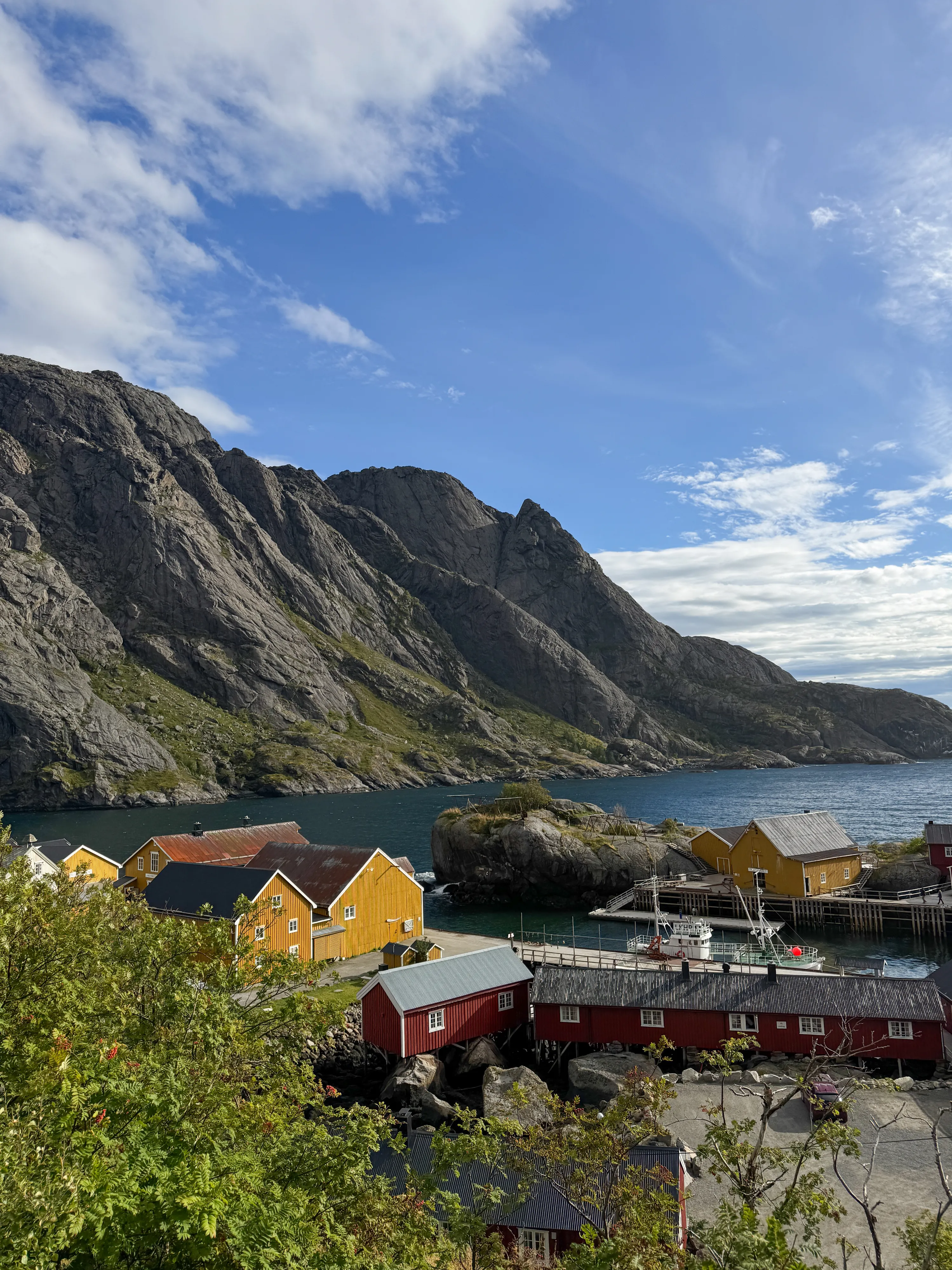
Nusfjord Town
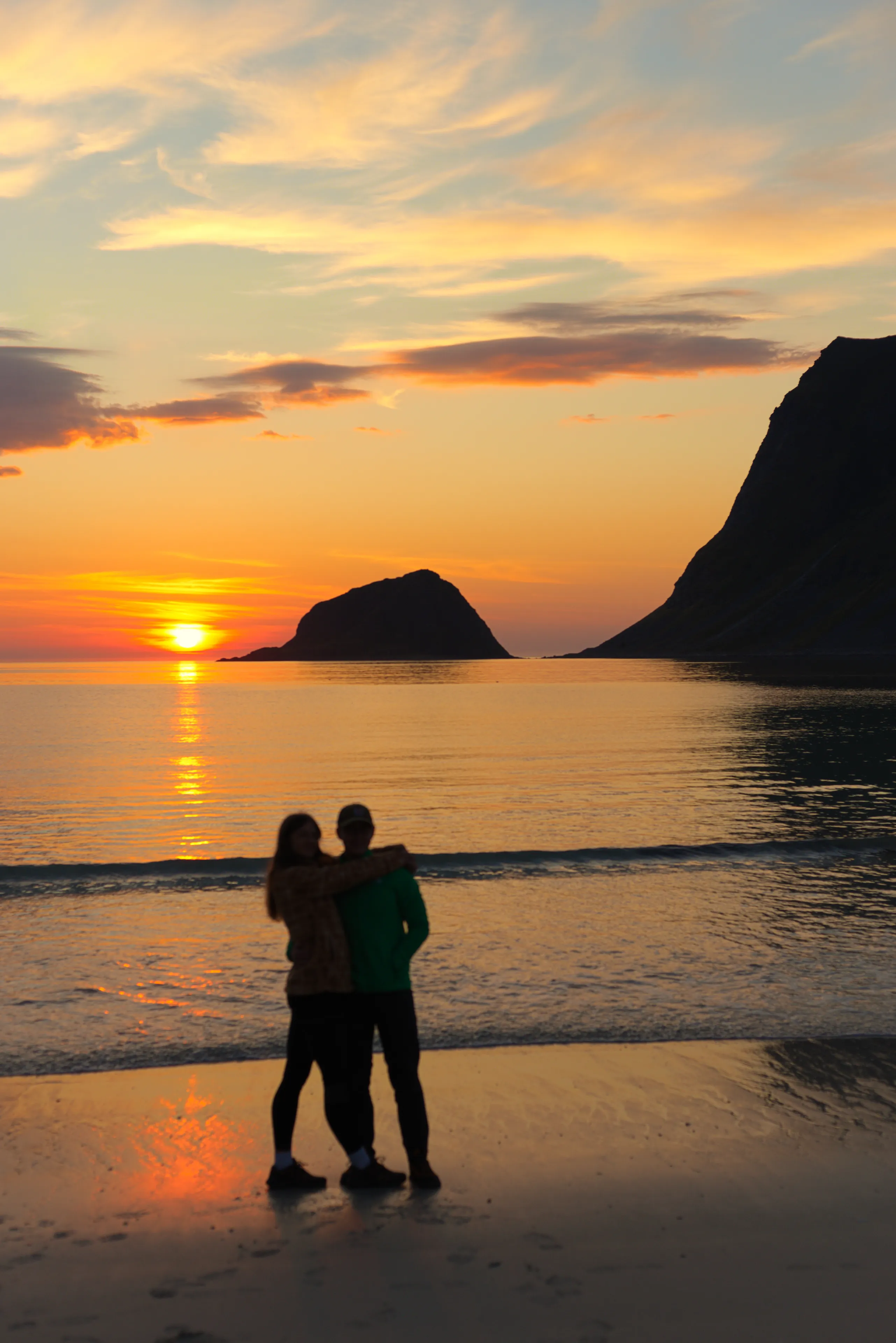
Vik Beach
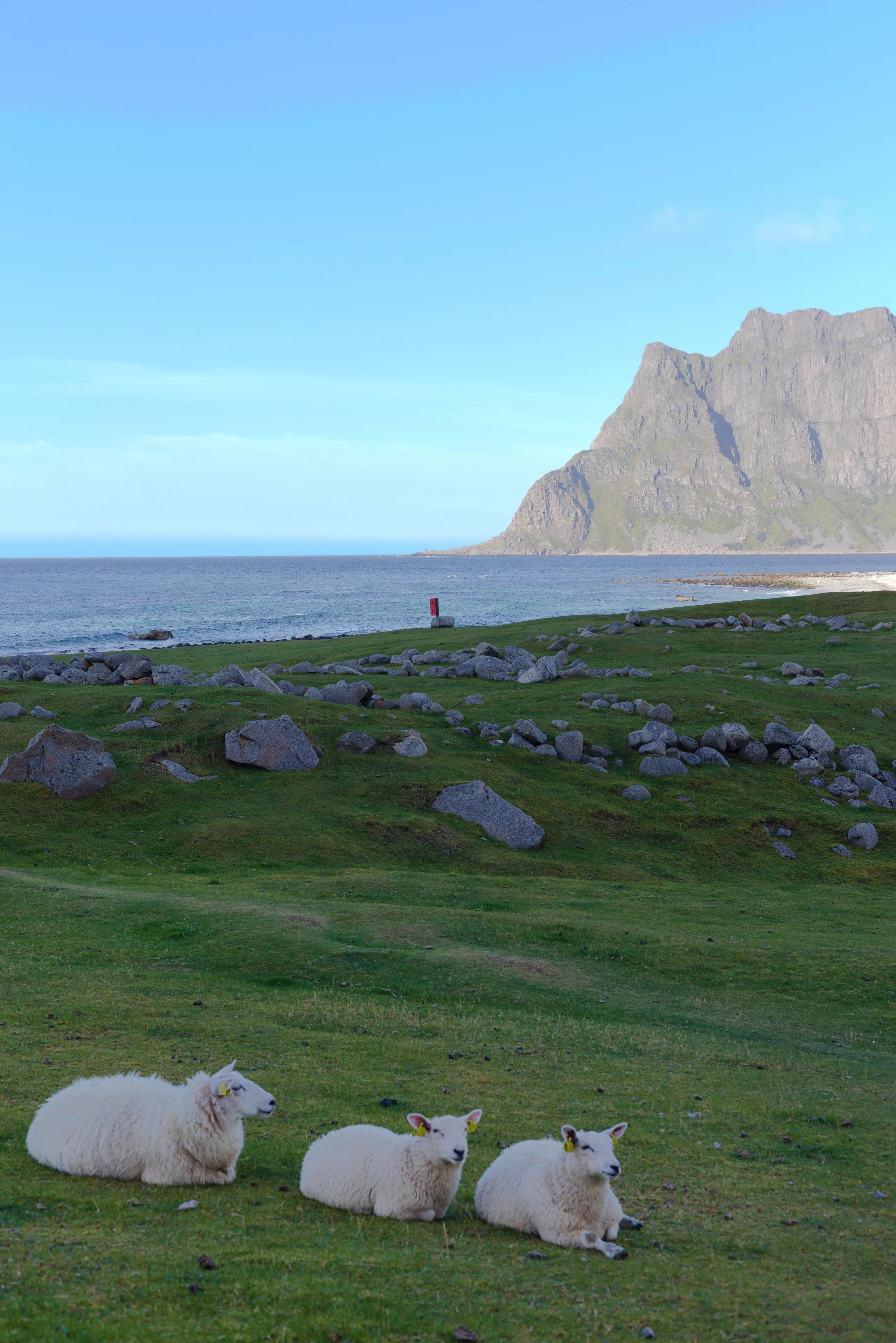
Uttakleiv Beach
The Lofoten archipelago lies beyond the Arctic Circle, in northern Norway. It attracts travelers with its rawness, tranquility, and extraordinary natural phenomena - from the Northern Lights in winter to white nights in summer. However, you should know that this is not a destination for everyone. The weather can be capricious, prices can surprise, and getting there requires good logistical preparation. Many trails lead through difficult terrain, often unmarked, so fitness and basic trekking equipment are needed. But those who decide to come here anyway will be able to experience contact with nature in its purest form, amazing views, and silence that is hard to find in more well-known destinations.
Climate and Weather - What You Should Know
The weather on the Lofoten Islands, typical for the Scandinavian region, can be quite capricious, and for most of the year it's cool, while rain and strong winds are frequent. The best time to visit the Lofoten Islands is between July and September, unless you plan to see this region in its winter version and experience the polar night. However, the peak tourist season falls in July, when the polar day lasts, meaning the sun practically doesn't set, and with favorable weather, you can enjoy long hours of light ideal for hiking and photographing landscapes. This period also offers the best chance of stable weather.
However, we decided to visit the Lofoten Islands in September, which turned out to be a bullseye. There were significantly fewer tourists on the trails, and the weather was great (temperatures ranged from 17 to 21 degrees). Additionally, from September onwards, the Northern Lights phenomenon begins to appear, which we also had the opportunity to admire. Simply real magic after dark!
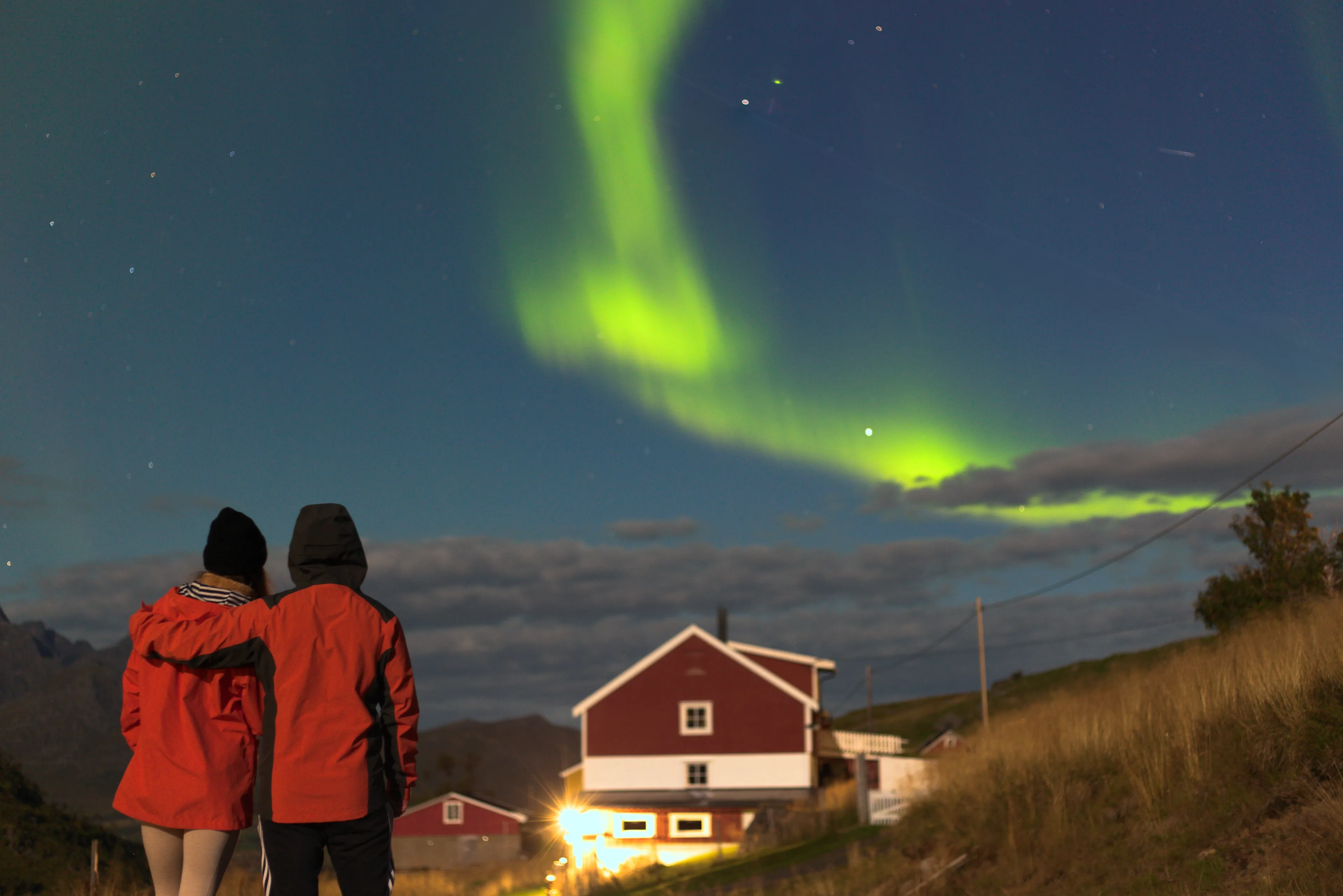
July
July is the peak tourist season on the Lofoten Islands. During this month, the polar day lasts, when the sun practically doesn't set, and light remains throughout the day. Temperatures are the highest of the year and usually range from 12 to 18 degrees, though with favorable weather it can even be above 20°C. Precipitation is less frequent than in other months, but capricious wind can still appear. This is an ideal time for trekking, kayaking, and photographing landscapes in full daylight.
August
August is still a good month for travel, as the weather is relatively mild, though days begin to shorten slightly. Temperatures stay in the range of 10–17°C, and precipitation may be more frequent than in July. You can still count on long hours of daylight, and with a bit of luck, you'll catch a few sunny days. This is also a good time to avoid the biggest crowds of tourists from July.
September
If you're packing for a trip to the Lofoten Islands during this seasonal period, prepare for everything. For warm weather, for rain and wind, and in the second half of September even snow. Don't rely 100% on weather forecasts. Although the Lofoten Islands are located far north, the climate is milder thanks to the Gulf Stream, a warm ocean current that, flowing from the Gulf of Mexico through the Atlantic, raises the air temperature over Norway. Thanks to this, in western and northern Norway, including the Lofoten Islands, conditions are milder than in other places at the same latitude. This current also brings an abundance of fish, which affects the local economy and traditional fishing. During our stay, we experienced this especially with strong winds - although they were strong, the air was relatively warm. When planning treks, however, it's worth having several layers of clothing with you and always having a rain jacket on hand, because the weather can change abruptly and differ between individual islands of the archipelago.
Weather Off-Season (October - June)
Outside the main tourist season, from October to June, the weather on the Lofoten Islands becomes more demanding and capricious.
In autumn, temperatures drop to about 0 - 10°C, days become shorter, and rain, snow, and strong winds are more frequent.
Winter on the Lofoten Islands is relatively mild thanks to the Gulf Stream - temperatures usually oscillate between -2 and 5°C, while snow covers the archipelago and can make it difficult or even impossible to access some trails. In December, the polar night begins, when the sun practically doesn't rise. This is an ideal time for a trip if you want to feel a truly festive atmosphere in a winter climate, and also if you want to hunt for the Northern Lights. Spring comes slowly, in April there may still be snow, and temperatures range from 0 to 10°C. In May and June, days become longer, temperatures rise to 10–15°C, and nature comes to life. This is a period when there is already a lot of daylight, and landscapes become green and picturesque, although it's still worth being prepared for unpredictable weather and wind.
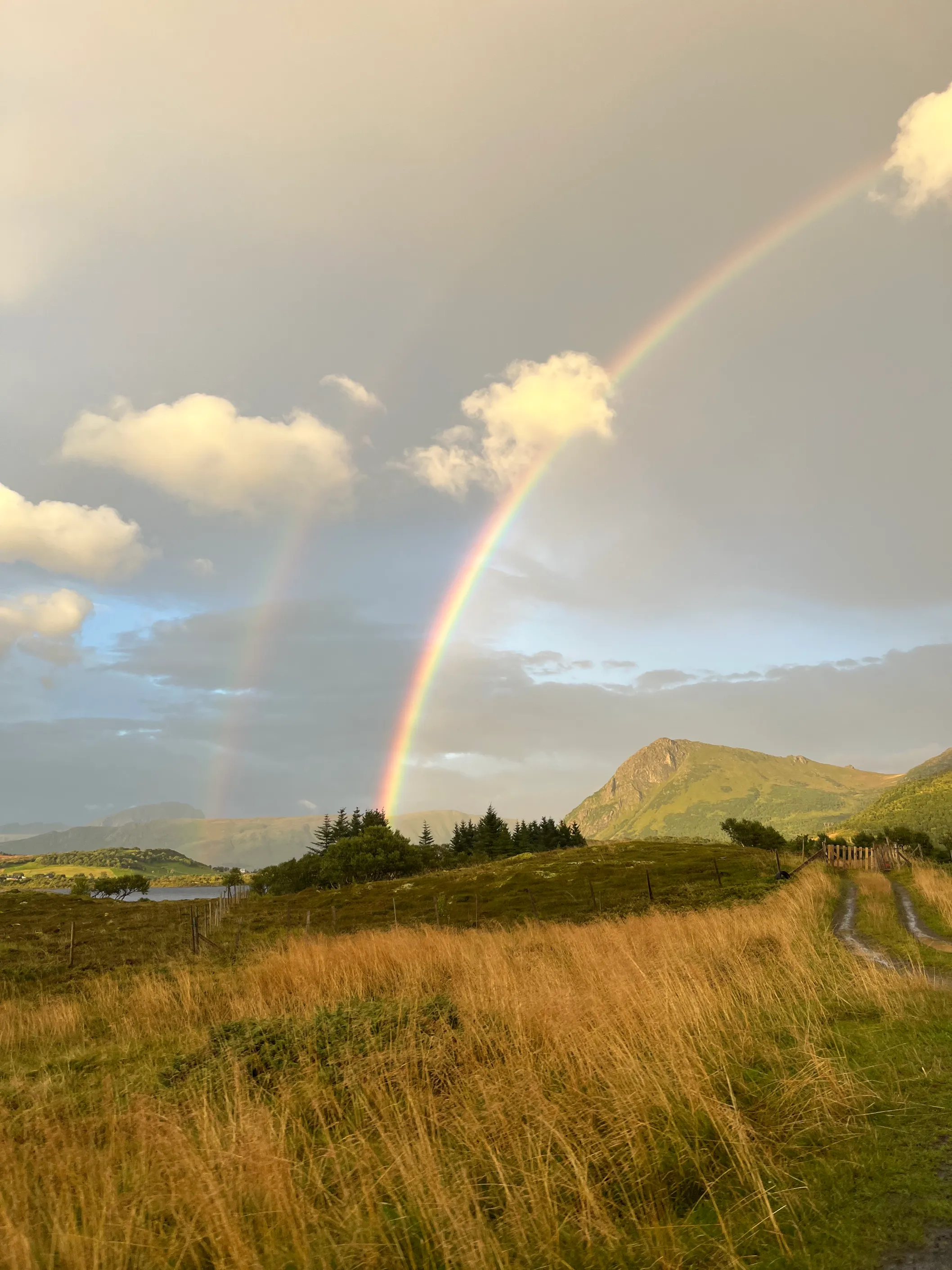
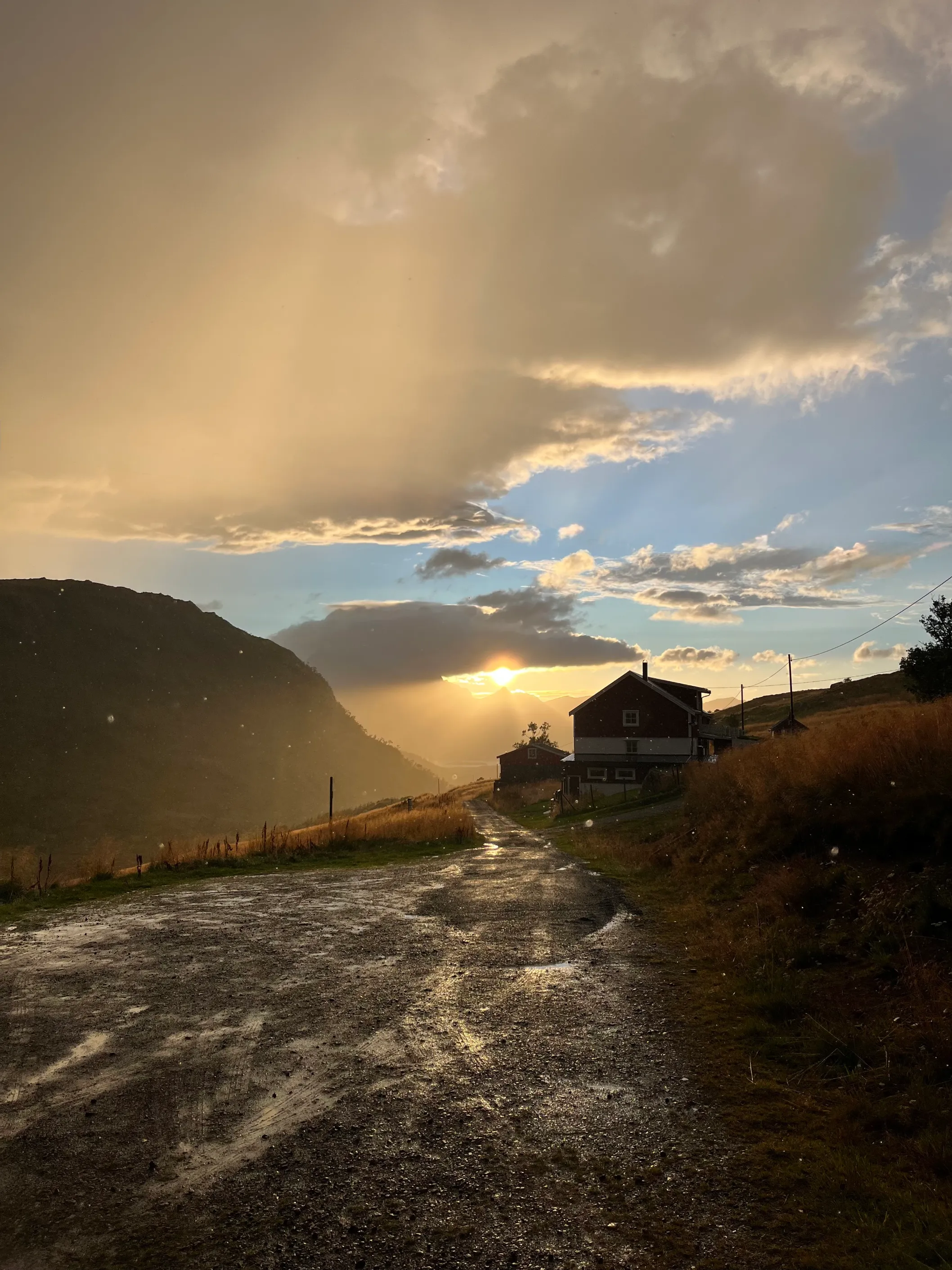
Transport and Accommodation
How to Get to Lofoten
Flight from Gdańsk to Tromsø
We decided on this option. It's quite demanding, more comfortable when drivers can take turns. We drove in a group of 4 by car from Katowice to Gdańsk (because only from here are there direct flights from Poland to Tromsø). Tromsø is located in northern Norway, about 480 km from the Lofoten Islands, where the car journey takes about 7 hours. Despite this distance, the route from Tromsø to Lofoten is incredibly scenic and worth every minute. From the very beginning of the journey, we pass picturesque fjords, monumental mountain peaks, and characteristic Scandinavian cottages. The route encourages frequent stops, almost every bay tempts you to stop and take photos. This was a foretaste for us of the views that awaited us later on the Lofoten Islands themselves. Car travel also gives you great freedom - you can stop at any points, explore smaller islands, and fully enjoy the beauty of the landscapes. We rented a car from Poles living in Norway; we write about the details later in the article.
Flights to Bodø and Ferry
An option often chosen by tourists to reach the Lofoten Islands is a flight with connections (most often to Bodø). From Poland, numerous connections to Oslo are available from various cities, such as Warsaw, Krakow, or Gdansk. Flight time is about 2 hours. From Oslo, daily domestic flights go to Bodø. Flight time is about 1.5 hours. From Bodø, ferries regularly run to Moskenes on the Lofoten Islands. The cruise takes about 3–3.5 hours. In the summer season (from late May to late August), early ticket reservation is recommended, especially if you're traveling with a car. Current prices, schedule times, and booking options can be found on the official website - https://www.torghatten.no/en.
Flights with Connections
There is one more option to get to the Lofoten Islands, exclusively by air. You can find flight connections with a transfer to Bodø, and from there fly on with domestic Wideroe airlines to Leknes. Since the airport in Leknes is really tiny, you can only get there with smaller planes of this airline. This option involves a flight with at least 3 connections and an average 10-12 hour journey to get to the heart of the Lofoten Islands. You can check possible connections for a specific date on the website - https://www.momondo.pl/flight-search/KTW-LKN/2026-07-18/2026-07-27?fs=fdDir=false&ucs=1gl8d34&sort=bestflight_a.
How to Get Around the Islands - Practical Tips
Since the archipelago consists of many islands, the route between them is very scenic. The main E10 road running along the entire archipelago leads between bays and high towering peaks, sometimes as if emerging from the water. When turning off the main road to a smaller town, you'll usually have to drive narrow roads with designated passing places.
In Norway, it's worth driving by the rules, because fines are quite high and can be issued from minimal violations. Especially since on the road from Tromsø there are many speed cameras, sometimes even one after another (speed cameras are marked in advance with signs). On the Lofoten Islands themselves there aren't too many speed cameras, but it's still worth being careful. The same applies to parking spaces. You can't park at passing places or other places not designated for this.
Refueling - on the Lofoten Islands, distances between gas stations can be considerable, and fuel prices are high. It's worth refueling when you have the opportunity, even if you're not close to the end of your tank. In larger towns (Svolvær, Leknes, Henningsvær, Reine), you won't have a problem finding a station.
In Norway, it's mandatory to use lights year-round (even during the day). Make sure the lights work well, because night falls quickly and visibility can be limited.
Where to Look for Accommodation
The Lofoten Islands are still a place with fairly limited tourist infrastructure. The archipelago is only partially developed, so you won't find many large hotels or a huge selection of accommodations here, especially at peak season. In practice, popular apps work best, such as Airbnb or Booking, where you can find private apartments, cottages, and guesthouses. If you book with adequate advance notice, you have a chance to find interesting options at a decent price. However, it's worth remembering that in July and August prices rise significantly and availability shrinks quickly.
For those who dream of atmospheric and unique accommodation, traditional rorbuer are an excellent choice. These are fishermen's cottages characteristic of Norway, often standing on stilts partially over water, used in the old days as shelter by fishermen. Today they are adapted for tourism, often beautifully restored and equipped with modern amenities. However, you should expect that accommodation prices in rorbuer are higher than in standard apartments or guesthouses.
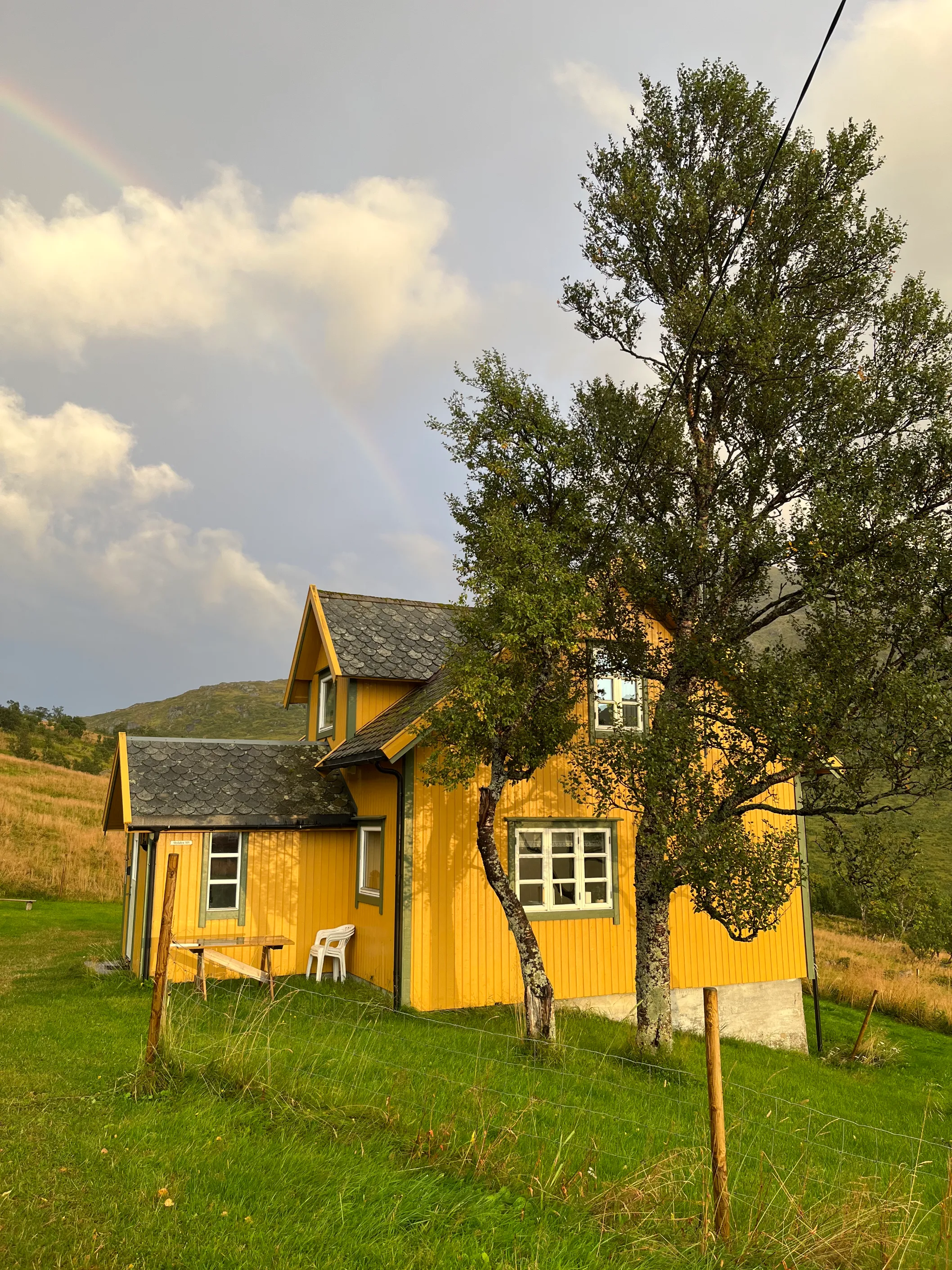
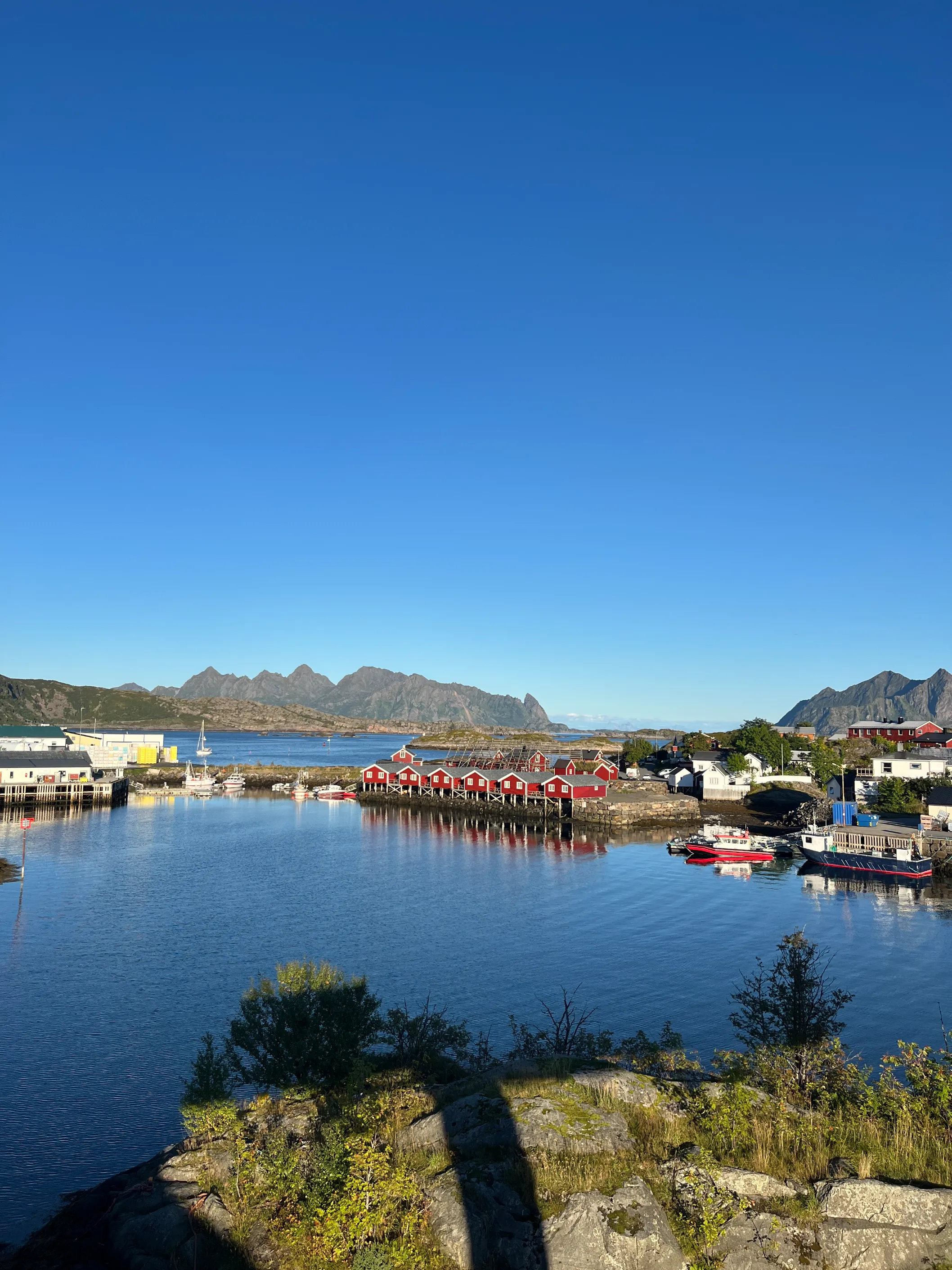
It's also worth considering accommodation at campsites, which are popular throughout Norway. This is an interesting option if you're traveling by car or camper, and there are plenty of places on the Lofoten Islands adapted precisely for this type of travel.
What to See on the Lofoten Islands
Map - Most Interesting Places and Attractions
Map - https://maps.app.goo.gl/e66bcCEW2mYcZ7Ks7
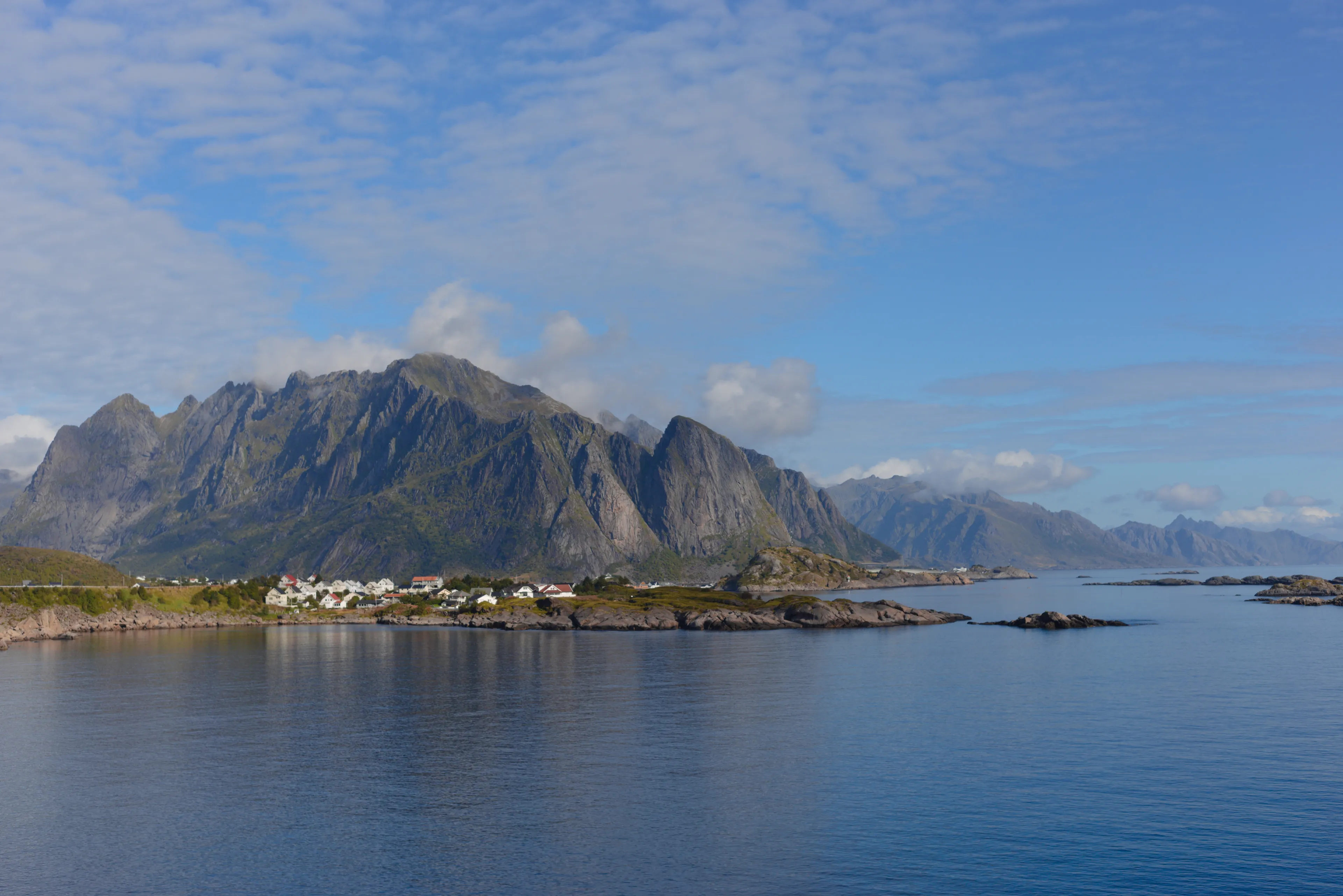
Reine Town
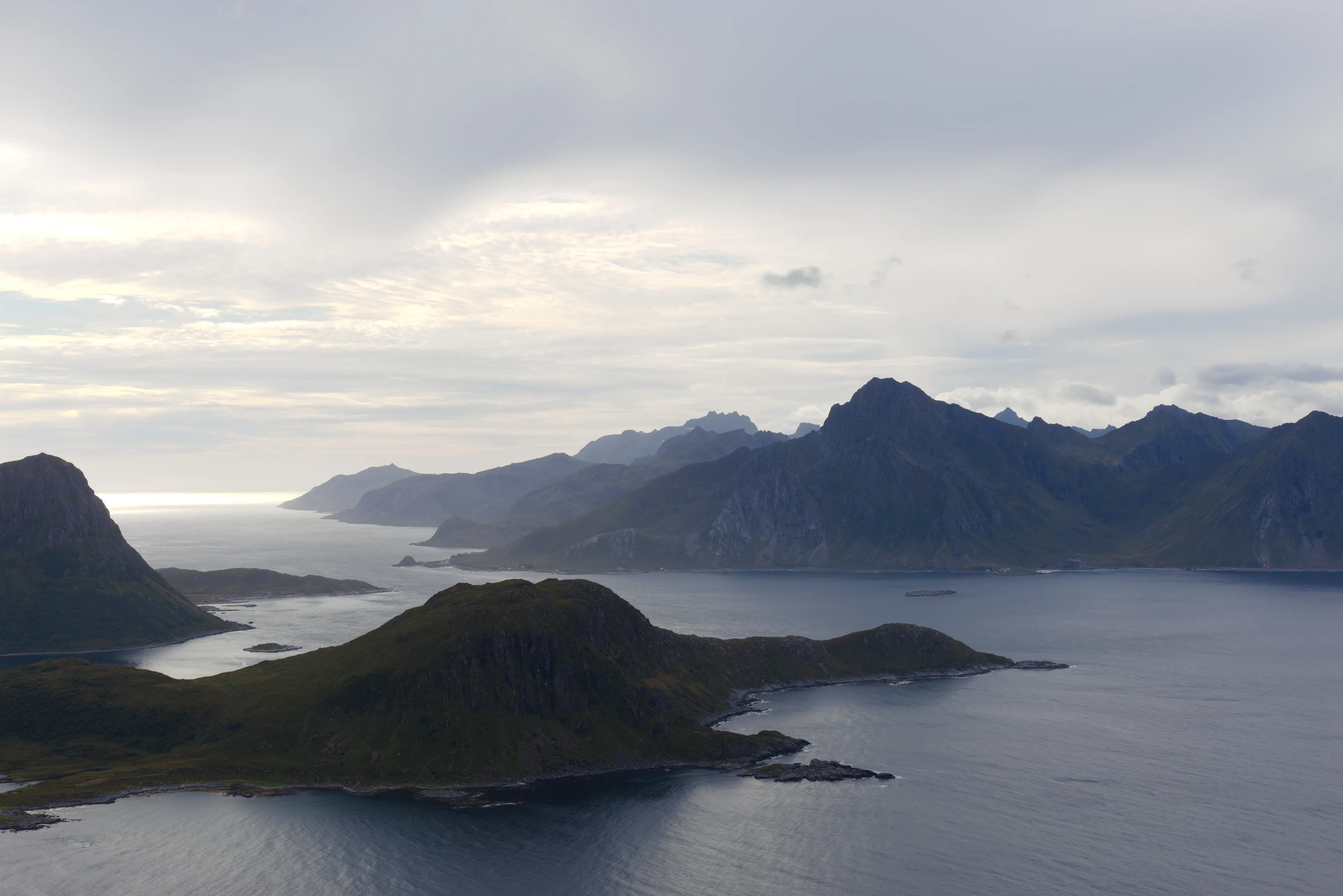
View from Mannen summit
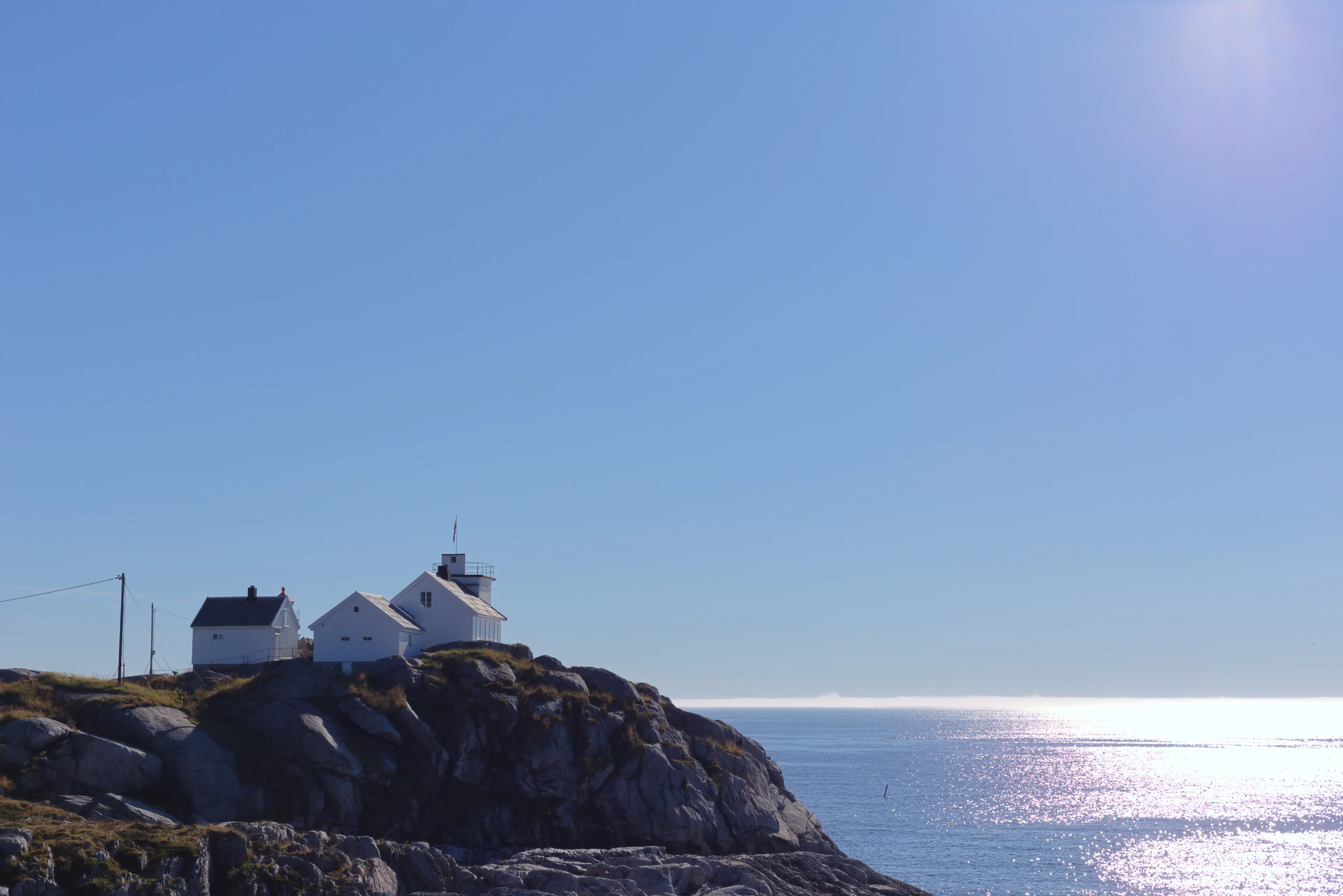
Viewpoint from Henningsvær
Practical Information
Good to Know
Before you hit the trail, it's worth checking out webcams (example website - https://www.skylinewebcams.com/pl/webcam/norge/nordland/lofoten/henningsvaer.html). Here the weather is variable and can differ in different parts of the archipelago. In addition to checking the forecast, it's worth looking at the camera to see if any clouds have settled there.
Roaming - Norway is not in the EU, but belongs to the EEA zone, so roaming works the same as in EU countries. You can freely use the Internet and maps.
Toalety - mostly at parking lots, in small towns, and near trails, and it's usually clean, tidy, and in many cases free.
Szlaki - most trails are unmarked, so it's worth using an additional map app
Korona norweska - in Norway, the currency is the Norwegian krone, but the country is already moving away from cash payments. Almost everywhere there is the possibility to pay by card, even for toilets.
Woda pitna - tap water, practically throughout Norway, is drinkable and really good! It's worth having spare bottles with you.
You can fly to Norway using an ID card or passport - Norway is in the Schengen zone.
What to Pack
Before departure, don't forget to purchase travel insurance and obtain the EHIC card
You must have trekking equipment, including appropriate mountain shoes, a rain jacket, and thicker layers of clothing; thermal clothing will also be useful
If you're not traveling during the polar day period, it's worth bringing a headlamp, which can be useful in case of returning from sunset or during nighttime Northern Lights hunts
Food and Prices in Norway
Fuel at stations is in the range of 19-22 NOK. Usually in larger cities, fuel is slightly cheaper. So it's worth not leaving refueling to the last moment, because on the Lofoten Islands, outside the cities, there aren't many gas stations, and prices there may be higher.
It's worth shopping at larger supermarkets located in cities. The cheapest stores are Kiwi and Rema 1000, quite popular in larger ones
However, it's worth bearing in mind that most supermarkets don't operate on Sundays; exceptions are small local shops (often at gas stations). Sometimes even large supermarkets on Sundays open small rooms where they conduct smaller sales. But despite everything, it's good to plan shopping in advance.
Car
Rental
In addition to standard car rental companies (those known worldwide - both large firms and local rental companies), which you can easily find on the internet, we have two more options for renting a car for you. There is a special app where private individuals offer their cars for rent - it's called Getaround. It's worth looking there and comparing with other offers. There is also the possibility of looking for a car on Facebook groups, where many Poles living in Norway offer to rent their cars; prices and conditions are to be discussed directly, but usually prices turn out to be much more favorable, and private individuals don't impose additional fees for a larger number of drivers or exceeding the kilometer limit.
Tips
Before departure, check what the rental car insurance covers and what the traffic regulations are (e.g., speed limits), because fines here are really high!
What to Try
Local cuisine has been famous here for centuries for fish, and particularly popular here is stockfish (dried cod). In Leknes there is a restaurant that prepares grilled stockfish - Makalaus (Storgata 27, 8370 Leknes) - Makalaus. You can also eat well-prepared fish at the Seafood Center in Leknes (check opening hours) - Lofoten Seafood Center. Here you can also visit an exhibition about fish farming and buy stockfish snacks.
Also popular in Norway are cinnamon rolls. We won't recommend a specific place to you because you can find them in most cafes. However, it's worth allowing yourself to try them.

Useful Apps
Easy Park
Parking app. It's worth remembering that on the islands, city parking lots are mostly paid. Fortunately, most of them are centralized in one app. This greatly facilitates payment. You download one app, connect your card to it, and you have the ability to control parking time even while on a summit (if you have coverage), and if you miscalculate the time, you can shorten it when you reach the parking lot. In our opinion, a very convenient app.
Mapy.com
App for mountain trails. Since trails on the Lofoten Islands are mostly poorly marked, it's worth using a map additionally. This app worked best for us.
Windy.com
App for checking current weather including cloudiness, rainfall, or wind. Thanks to it, it's easier to check if any rain clouds are forming and in which direction they're heading.
Google Maps
It worked very well for us while driving, it indicated detours and closed routes, and also showed where speed cameras are.
SpaceWeatherLive or My Aurora Forecast & Alert
Apps for checking parameters for the probability of aurora occurrence in a given area. Useful for hunting the Northern Lights.
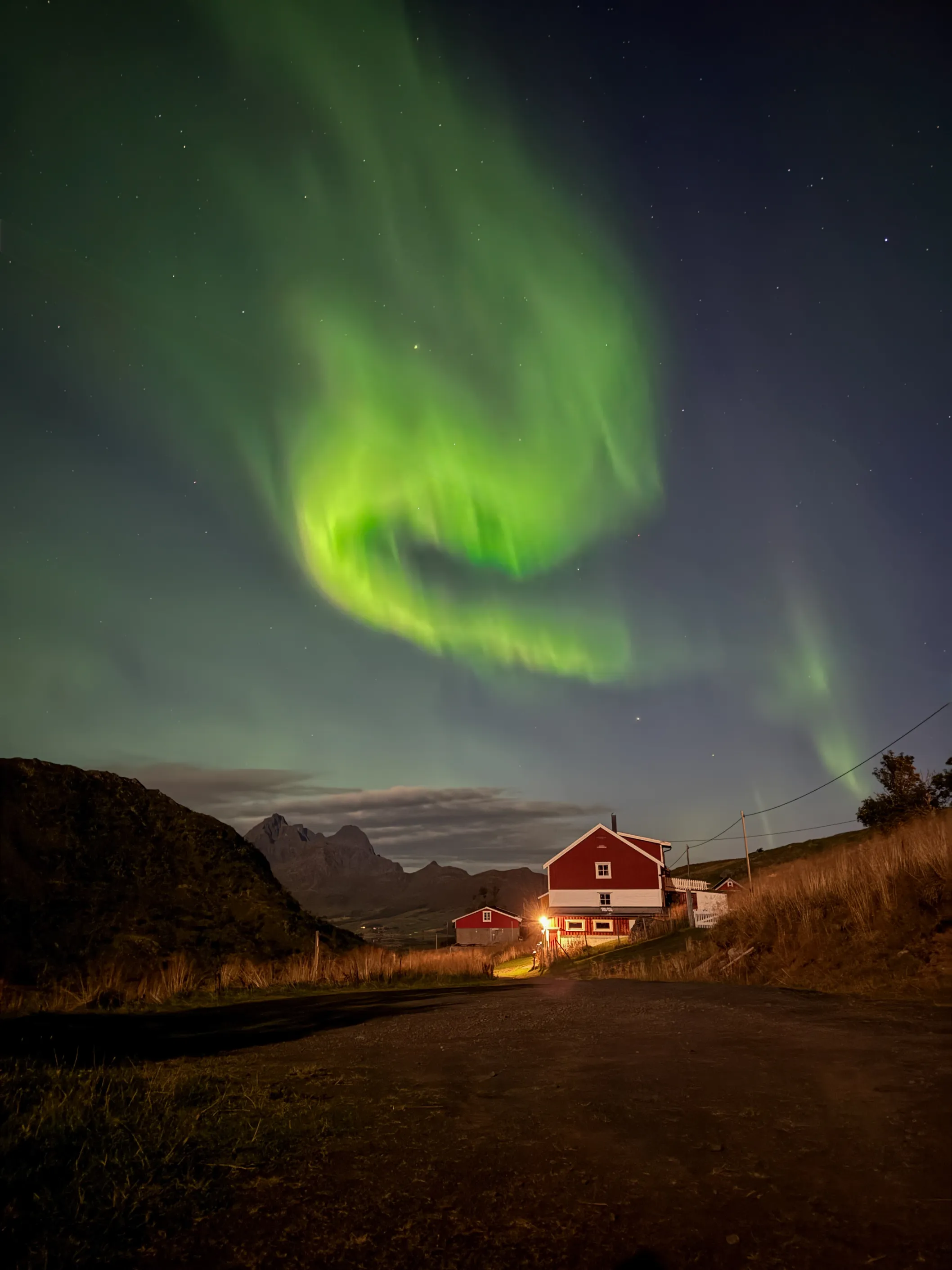
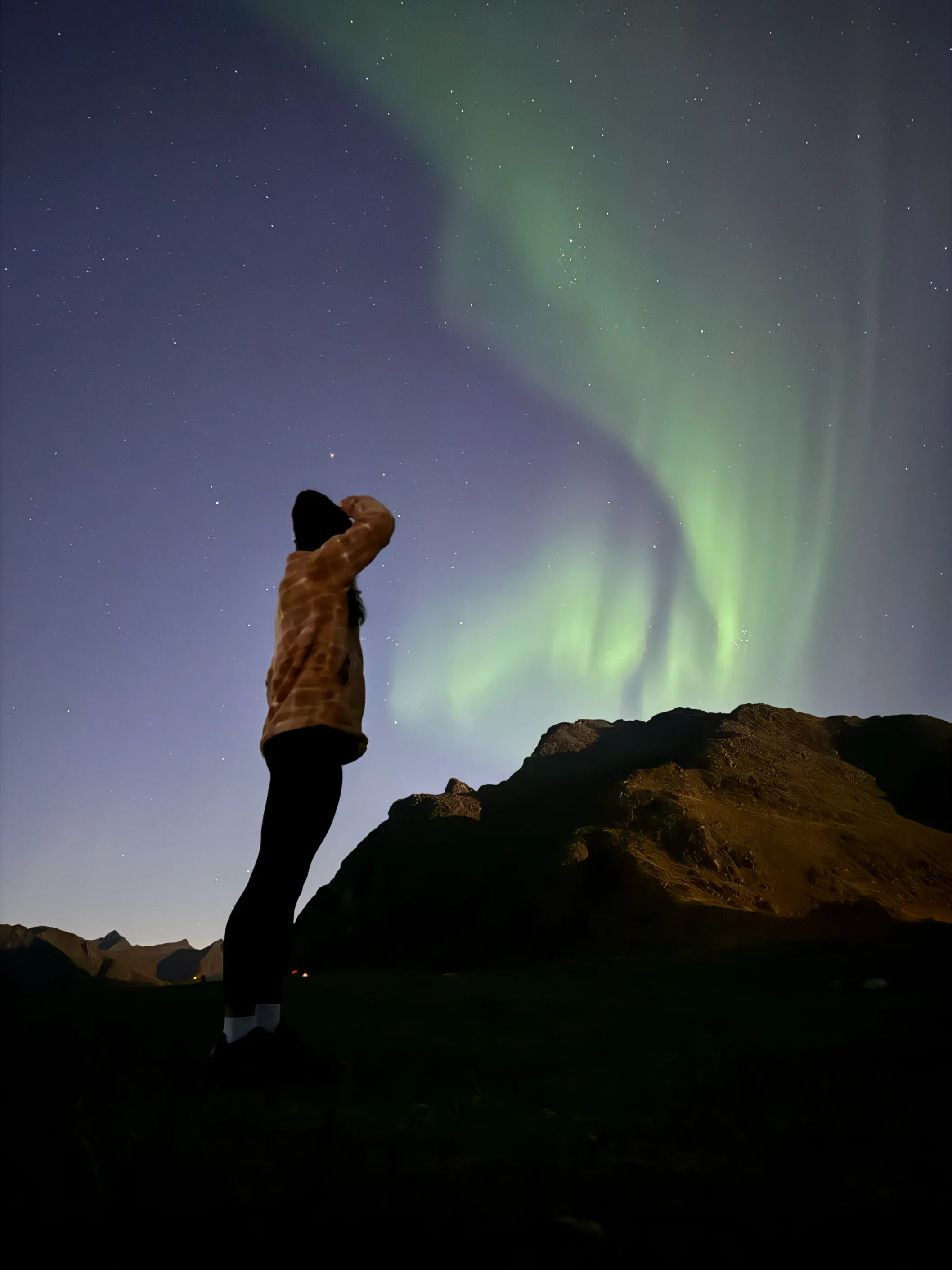
And if you want to stay up to date with more travel inspirations, check out our Instagram!
@journeysjar